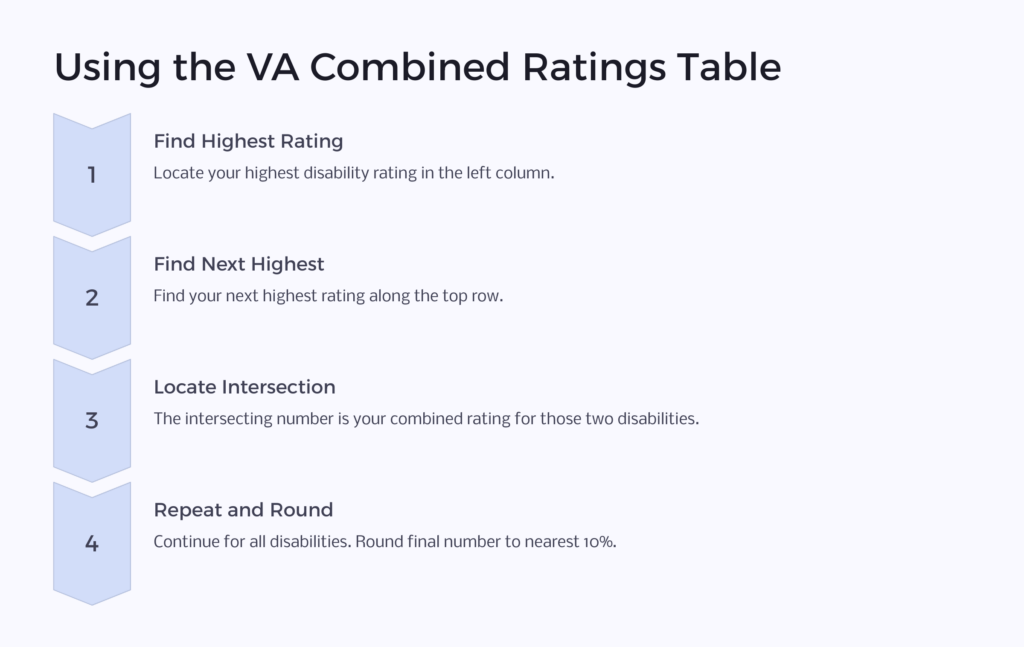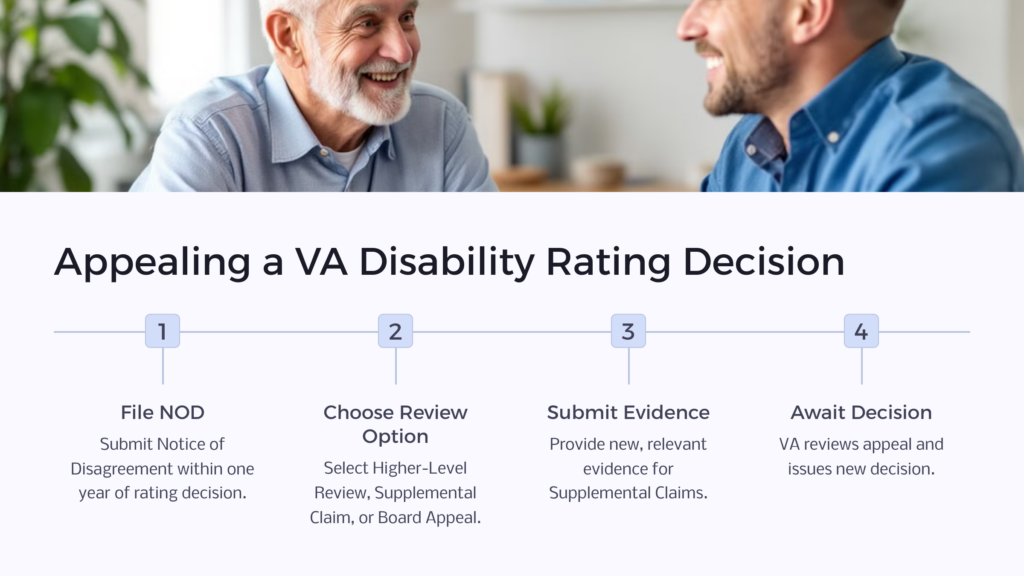
VA Math, short for Veterans Affairs Mathematics, is a special system used by the Department of Veterans Affairs to calculate combined disability ratings for veterans with multiple service-connected conditions. Unlike regular math where you simply add percentages together, VA Math uses a unique formula to determine a veteran’s overall disability rating.
Understanding VA Math is crucial for veterans because it directly impacts the amount of disability compensation they receive. A higher combined rating means more monthly benefits, so knowing how these calculations work can help veterans ensure they’re getting the benefits they deserve.
Many veterans are surprised to learn that having two 50% disabilities doesn’t equal a 100% rating. This is where VA Math comes into play, using a complex system of efficiency ratings to determine the true combined impact of multiple disabilities on a veteran’s life.
How to Calculate Combined Disability Ratings

Calculating combined disability ratings using VA Math starts with understanding that the VA views each new disability in terms of its impact on your remaining efficiency. For example, if you have a 30% disability, the VA considers you 70% efficient.
To begin the calculation process:
1. List your disabilities from highest to lowest percentage.
2. Start with your highest rated disability.
3. Subtract that percentage from 100% to get your remaining efficiency.
4. Apply the next highest disability percentage to your remaining efficiency.
5. Continue this process for all your rated disabilities.
For example, if you have disabilities rated at 50%, 30%, and 20%:
– Start with 50%: 100% – 50% = 50% efficiency remaining
– Apply 30% to the remaining 50%: 30% of 50% = 15% efficiency remaining
– Subtract 15% from 50%: 50% – 15% = 35% efficiency remaining
– Apply 20% to the remaining 35%: 20% of 35% = 7% efficiency remaining
– Subtract 7% from 35%: 35% – 7% = 28% efficiency remaining
Your combined rating would be 100% – 28% = 72%, which rounds to 70%.
Step-by-Step Guide to Using the VA Combined Ratings Table

The VA Combined Ratings Table simplifies the complex calculations of VA Math. Here’s how to use it:
1. Find your highest disability rating in the left column.
2. Locate your next highest rating along the top row.
3. The number where these two intersect is your combined rating for those two disabilities.
4. If you have more than two disabilities, use this new combined rating to find the intersection with your next highest disability.
5. Repeat until all disabilities are accounted for.
6. Round the final number to the nearest 10%.
For example, using the ratings 50%, 30%, and 20%: 1. Find 50 in the left column and 30 along the top. The intersection is 65. 2. Now find 65 in the left column and 20 along the top. The intersection is 72. 3. Round 72 to 70%, which is your final combined rating.
Remember, the VA Combined Ratings Table is a tool to help visualize and simplify these calculations, but the underlying principle remains the same as the step-by-step math explained earlier.
Examples of VA Combined Ratings Calculations
Let’s look at a few more examples to solidify your understanding of VA Math and the combined ratings table:
Example 1
Disabilities: 60%, 40%, 20%
– 60 combined with 40 = 76
– 76 combined with 20 = 81
– 81 rounds to 80% final rating
Example 2
Disabilities: 70%, 50%, 30%, 10%
– 70 combined with 50 = 85
– 85 combined with 30 = 90
– 90 combined with 10 = 91
– 91 rounds to 90% final rating
Example 3
Disabilities: 50%, 50%, 30%, 20%, 10%
– 50 combined with 50 = 75
– 75 combined with 30 = 83
– 83 combined with 20 = 86
– 86 combined with 10 = 87
– 87 rounds to 90% final rating
These examples demonstrate how multiple disabilities combine and why simply adding percentages doesn’t work in the VA system. It’s important to use the official VA Combined Ratings Table or a reliable VA disability calculator to ensure accuracy.
Understanding the Bilateral Factor in VA Ratings
The bilateral factor is an important concept in VA Math that can increase your overall disability rating. It applies when you have disabilities affecting both arms, both legs, or paired skeletal muscles.
Here’s how the bilateral factor works:
- Combine the ratings for the bilateral disabilities using the standard VA Math method.
- Add 10% of this combined value to account for the bilateral factor.
- Use this new, higher rating when calculating your overall combined rating.
For example, if you have a 30% rating for your right knee and a 20% rating for your left knee:
- Combine 30% and 20% using the ratings table, which gives you 44%.
- Calculate 10% of 44%, which is 4.4%.
- Add 4.4% to 44%, giving you 48.4%.
- Use 48% (rounded down) as a single disability in your overall calculation.
The bilateral factor recognizes that having disabilities on both sides of the body often creates a greater impact than the individual ratings might suggest. This can be particularly beneficial for veterans with conditions affecting their limbs or paired muscles.
Common Mistakes to Avoid When Using the Combined Ratings Table
When working with VA Math and the Combined Ratings Table, there are several common mistakes that veterans should be aware of:
1. Adding percentages: The most frequent error is simply adding disability percentages together. Remember, VA Math doesn’t work like regular addition.
2. Ignoring the bilateral factor: Failing to apply the bilateral factor when appropriate can result in a lower overall rating than you deserve.
3. Rounding individual ratings: Only round the final combined rating to the nearest 10%. Don’t round individual disabilities or intermediate calculations.
4. Using outdated tables: Make sure you’re using the most current VA Combined Ratings Table. The VA occasionally updates its guidelines and calculations.
5. Misunderstanding efficiency: Remember that each new disability is applied to your remaining efficiency, not your overall health.
By avoiding these mistakes, you can ensure a more accurate calculation of your combined disability rating and potentially increase your VA benefits.
How to Appeal a VA Disability Rating Decision

If you believe the VA has incorrectly calculated your disability rating or if you think your conditions have worsened, you have the right to appeal. Here’s a basic overview of the appeals process:
1. File a Notice of Disagreement (NOD): This must be done within one year of receiving your rating decision.
2. Choose your review option: You can request a Higher-Level Review, file a Supplemental Claim, or appeal to the Board of Veterans’ Appeals.
3. Submit new evidence: If you’re filing a Supplemental Claim, provide new and relevant evidence to support your case.
4. Attend a hearing: If you’ve appealed to the Board, you may request a hearing with a Veterans Law Judge.
5. Wait for a decision: The VA will review your appeal and issue a new decision.
Remember, the appeals process can be complex and time-consuming. Consider seeking help from a Veterans Service Organization or a VA-accredited attorney to guide you through the process.
FAQs About VA Math and Combined Ratings
Here are some frequently asked questions about VA Math and combined ratings:
Q: Can my combined rating ever exceed 100%?
A: No, 100% is the maximum combined rating possible.
Q: How often can I request an increase in my disability rating?
A: You can request an increase at any time if you believe your service-connected condition has worsened.
Q: Does the order of my disabilities matter in the calculation?
A: Yes, always start with your highest rated disability and work down to the lowest for accurate calculations.
Q: What if my final combined rating ends in 5%?
A: The VA always rounds to the nearest 10%. So, a 55% rating would round up to 60%, while a 54% would round down to 50%.
Q: How does VA Math affect my monthly compensation?
A: Your combined rating determines your monthly disability compensation. Higher ratings result in higher monthly payments.
Understanding these common questions can help you navigate the VA disability system more effectively and ensure you’re receiving the correct benefits.
Latest Updates and Changes in VA Disability Ratings
The VA periodically updates its disability rating system to better serve veterans. Here are some recent changes to be aware of:
1. PACT Act: In 2022, the PACT Act expanded VA healthcare and benefits for veterans exposed to burn pits and other toxic substances.
2. Mental Health Ratings: The VA has been working on revising the rating criteria for mental health conditions to more accurately reflect their impact on veterans’ lives.
3. Presumptive Conditions: The list of presumptive conditions for certain eras of service continues to expand, making it easier for some veterans to establish service connection.
4. COVID-19 Impact: The VA has recognized some long-term effects of COVID-19 as potentially service-connected for veterans who contracted the virus during service.
Stay informed about these changes by regularly checking the VA website or speaking with a VSO representative. These updates could affect your disability rating and benefits.
Additional Benefits Based on Your Combined Rating
Your combined VA disability rating can unlock additional benefits beyond your monthly compensation. Here are some programs to be aware of:
1. Dependent Benefits: Veterans with a combined rating of 30% or higher may be eligible for additional compensation for dependents.
2. VA Healthcare: A service-connected disability rating, regardless of percentage, generally qualifies you for VA healthcare.
3. Property Tax Exemptions: Many states offer property tax exemptions for disabled veterans, with benefits often increasing at higher rating levels.
4. Education Benefits: Veterans rated at 100% may be eligible for additional education benefits for themselves or their dependents.
5. VA Home Loan: While available to most veterans, those with service-connected disabilities may have their funding fee waived.
6. Vocational Rehabilitation: Veterans with ratings of 20% or higher may qualify for VR&E services to help with job training and employment.
Remember to explore these additional benefits as your rating changes. They can provide significant support beyond your regular compensation.
Getting Help with Your VA Disability Claim
Navigating the VA disability system can be challenging, but you don’t have to do it alone. Here are some resources for getting help:
1. Veterans Service Organizations (VSOs): Organizations like the American Legion, VFW, and DAV offer free assistance with claims and appeals.
2. VA-Accredited Attorneys: Lawyers specializing in VA law can provide expert guidance, especially for complex cases or appeals.
3. VA Regional Offices: Schedule an appointment with a VA representative for personalized assistance.
4. Online Communities: Websites and forums dedicated to veteran issues can provide peer support and shared experiences.
5. VA Claim Clinics: Some VA facilities and veteran centers host clinics where you can get help with your claim in person.
Remember, while these resources can be incredibly helpful, the final decision on your claim always comes from the VA. Stay proactive, keep good records, and don’t hesitate to seek help when you need it.
Understanding VA Math and the combined ratings table is crucial for every veteran seeking disability benefits. By mastering these concepts, you can ensure you’re receiving the correct rating and maximum benefits you’ve earned through your service. Always stay informed about updates to the VA system and don’t hesitate to seek assistance when navigating this complex process. Start today by taking our quiz at Benefits.com to see what you’re eligible for.
 Benefits.com Advisors
Benefits.com Advisors
With expertise spanning local, state, and federal benefit programs, our team is dedicated to guiding individuals towards the perfect program tailored to their unique circumstances.
Rise to the top with Peak Benefits!
Join our Peak Benefits Newsletter for the latest news, resources, and offers on all things government benefits.


















